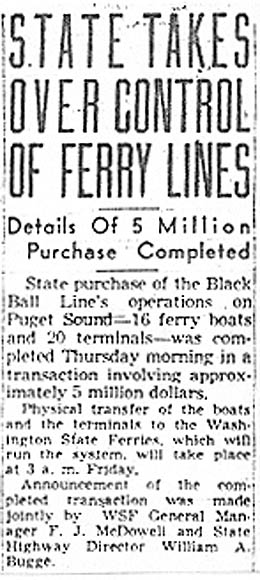On June 1, 1951, Washington State Ferries (WSF) begins operations on Puget Sound, after taking control from the Puget Sound Navigation Company (Black Ball Line), which had been operating the ferries for decades. One era ends, while another begins.
The first day under Washington State Ferries operations was held with little fanfare. A small delegation representing most of the ports served by the ferries traveled throughout the day to a variety of small ceremonies in various cities, and at the grave of Chief Seattle (178?-1866) in Suquamish. Governor Arthur Langlie (1900-1966) was in attendance, along with Highway Director William Bugge.
The official changeover occurred at 3:00 a.m. The ferry Enetai made the last run of the Black Ball line. She docked at Bremerton and dropped off her passengers at 2:30 a.m., at which point the Black Ball flag was lowered from her mast for the last time. When the ferry Vashon began her regular run at 5:20 a.m. from Lofall, she was the first ferry in operation under the new state-run system. Throughout the day, the other ferries operated on their regular schedules.
Business as Usual
Passengers noticed little difference. The schedules remained the same, and a large majority of ferry workers came over directly from the Black Ball Line, so many of the same faces graced the decks. The orange smokestacks were in the process of being painted green, but the rest of each ship looked the same as it did every morning. The truly observant may have noticed that the signature landing call blown on the whistle was now one long blast followed by a short, instead of one long and two shorts.
Embarking and disembarking were handled the same as always, although riders received a yellow pamphlet explaining the future plans of the new state-run organization. Washington State Ferries offices took over the offices of the Black Ball Line, and even the phone number (3-2579) was unchanged. The biggest difference was that the president's office, which had been the domain of Captain Alexander Peabody (1895-1980), was now the office of WSF General Manager Floyd McDowell.
The state had recently bought out most of the fleet and operations from Captain Peabody after a years-long battle in which much of the public felt that the privately owned system constituted a monopoly. After suffering through shutdowns and rate hikes, an angry citizenry convinced lawmakers to step in and let the state run the ferry system in such a way that it could be made more accountable to the populace. Plus, many assumed that a network of bridges and tunnels would soon be crisscrossing Puget Sound, making ferries obsolete. To them, the ferry system was only temporary.

